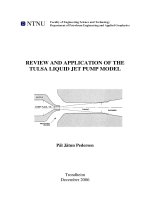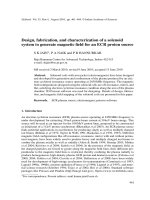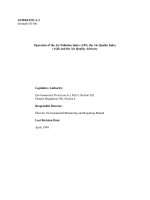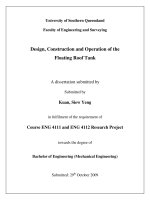Design, Construction and Operation of the Floating Roof Tank pot
Bạn đang xem bản rút gọn của tài liệu. Xem và tải ngay bản đầy đủ của tài liệu tại đây (5.77 MB, 189 trang )
University of Southern Queensland
Faculty of Engineering and Surveying
Design, Construction and Operation of the
Floating Roof Tank
A dissertation submitted by
Submitted by
Kuan, Siew Yeng
in fulfilment of the requirement of
Course ENG 4111 and ENG 4112 Research Project
towards the degree of
Bachelor of Engineering (Mechanical Engineering)
Submitted: 29
th
October 2009
i
ABSTRACT
Storage tanks have been widely used in many industrial particularly in the oil refinery
and petrochemical industry which are to store a multitude of different product with crude
oil as one if it. There are different types of tank such as fixed roof tank, open roof tank,
floating roof tank etc. Floating roof tank is which the roof floats directly on top of the
product, with no vapour space and eliminating the possibility of flammable atmosphere.
There are various industrial code and standard available for the basic requirement for
tank design and construction. Commercial software are also available in the market for
the basic design, hence tank designer would rely wholly on the software without detail
understanding. Despite of the various standard and code, there is limited procedure and
rules in designing the floating roof which result lots of floating roof failure and caused
injuries and fatalities accident. Design and safety concern has been a great concern for
the increasing case of fire and explosion due the tank failure.
The main objective of this project is “HOW TO DESIGN A NEW FLOATING ROOF
TANK”. The aim of this project is to develop basic rules and procedures, highlighting the
concerns in designing, construction and operation of a floating roof by taking an existing
Oil Development Project with it’s readily available information as a base, to design the
tank, and identify the problematic and lesson learnt throughout the project.
ii
University of Southern Queensland
Faculty of Engineering and Surveying
ENG 4111 & ENG 4112 Research Project
Limitations of Use
The Council of the University of Southern Queensland, its Faculty of Engineering and
Surveying, and the staff of the University of Southern Queensland, do not accept any
responsibility for the truth, accuracy or completeness of material contained within or
associated with this dissertation.
Person using all or any part of this material do so at their own risk, and not at the risk of
the Council of the University of Southern Queensland, its Faculty of Engineering and
Surveying or the staff of the University of Southern Queensland.
This dissertation reports an education exercise and has no purpose or validity beyond this
exercise. The sole purpose of the course pair entitled “Research Project” is to contribute
to the overall education within the student’s chosen degree program. This document, the
associate hardware, software, drawings, and other material set out in the associated
appendices should not be used for any other purpose: if they are so used, it is entirely at
the risk of the user.
Prof Frank Bullen
Dean
Faculty of Engineering and Surveying
iii
Certification
I certify that the ideas, designs and experimental work, results, analyses and
conclusions set out in this dissertation are entirely my own effort, except where
otherwise indicated and acknowledged.
I further certify that the work is original and has not been previously submitted for
assessment in any other course or institution, except where specifically stated.
KUAN SIEW YENG
0050012450
_____________________
Signature
_____________________
Date
iv
Acknowledgment
This research was carried out under the principal supervision of Dr. Harry Ku and the co-
supervisor is Dr. Talal. I would like express my great appreciation toward them for their
kind valuable assistance and advice through out the project.
Beside that, I would like to thanks the library of Technip Malaysia which had provided
me a lot of handful information and reference book as this project requires lot of
reference and international code.
v
TABLE OF CONTENT
CONTENTS PAGE
ABSTRACT i
ACKNOWLEDGMENT iv
LIST OF FIGURES xi
LIST OF TABLES xvi
CHAPTER 1: INTRODUCTION
1.1 Rationale 1
1.2 Research Goal 2
1.2.1 Project Aims 2
1.2.2 Project Objective 2
1.3 Research Methodology
1.3.1 Literature Review 3
1.3.2 Case Study 3
1.3.3 Product Enquiries 3
1.3.4 Design Approach 3
1.3.5 Consequential Effect of the Design Failure 4
1.3.6 Special Design and Construction 4
CHAPTER 2: LITERATURE REVIEW
2.1 Introduction 5
2.2 Type of Storage Tank 7
2.2.1 Open Top Tank 7
2.2.2 Fixed Roof Tanks 8
2.2.3 Floating roof Tanks 9
vi
2.3 Design Code and Standard 10
2.4 Floating Roof Tank 11
2.4.1 History and Introduction 11
2.4.2 Principles of the Floating roof 11
2.4.3 Advantages of the Floating Roof Storage Tank 13
2.5 Design Data Overview 13
2.6 Process Description and Requirements 15
2.7 Process Description and Design Consideration 16
2.8 Material Selection and Corrosion Assessment 19
2.8.1 CO2 Corrosion 19
2.8.2 Carbon Dioxide Corrosion Modeling 21
2.9 Mechanical Selection of Carbon Steel Grade 22
2.10 Mechanical Design 25
2.11 Tank Shell Design Method as Per API 650 26
2.11.1 Calculation of thickness by 1-Foot Method 26
2.11.2 Calculation of thickness by Variable-Design-
Point Method 27
2.11.3 Calculation of thickness by Elastic Analysis 28
2.12 Mechanical Design consideration 28
2.13 Bottom Plate Design 30
2.13.1 Vertical Bending of Shell 30
2.14 Floating Roof design 31
2.15 Special Consideration 32
2.15.1 Soil Settlement 32
2.15.2 Seismic Design for Floating roof 33
2.16 Failure Mode Due to Seismic Effects on Floating Roof Tank 34
2.17 Fitting Design and Requirement 36
2.18 Typical Fitting and Accessories for Floating Roof 37
vii
2.18.1 Roof Seal System 37
2.18.2 Support Leg 38
2.18.3 Roof Drain System 39
2.18.4 Vent – Bleeder vents 43
2.18.5 Centering and Anti-Rotation Device 44
2.18.6 Rolling Ladder and Gauger Platform 44
2.19 Fire Fighting System and Foam Dam 44
CHAPTER 3: TANK DESIGN
3.1 Introduction 46
3.2 Shell Design 46
3.2.1 Longitudinal Stress 47
3.2.2 Circumferential Stress 48
3.2.3 Longitudinal Stress versus Circumferential Stress 49
3.2.4 Circumferential Stress Thickness Equation and
1-Foot Method 49
3.2.5 Shell Design Thickness calculation 50
3.2.6 Top Stiffener and Intermediate Wind Girder Design
3.2.6.1 Top Stiffener/ Top Wind Girder 51
3.2.6.2 Intermediate Wind Girder 54
3.2.7 Overturning Stability against Wind Load 57
3.2.8 Seismic Design 60
3.2.8.1 Site Geometry Design Data for
Seismic Design 62
3.2.8.2 Overturning Stability 62
3.2.8.3 Design Spectral Accelerations 64
viii
3.2.8.4 Parameter required for Seismic Design 65
3.2.8.5 Effective Weight of Product 69
3.2.8.6 Center of Action for effective Lateral Force 71
3.2.8.7 Ring Wall Moment 72
3.2.8.8 Base Shear Force 72
3.2.8.9 Resistance to Overturning 74
3.2.8.10 Anchorage Design 77
3.2.8.11 Freeboard 78
3.2.8.12 Seismic design Summary 79
3.3 Roof Design 80
3.3.1 Roof type Selection 80
3.3.2 Pontoon and Center deck Design 81
3.3.2.1 Roof Stress Design 82
3.3.2.2 Effect of large Deflection on Center Deck 83
3.3.2.3 Pontoon Stability – Pontoon Ring Design 86
3.3.3 Fitting and Accessories Design 89
3.3.3.1 Roof Seal System 90
3.3.3.2 Roof Seal Material 95
3.3.3.3 Roof Support Leg 96
3.3.3.4 Venting System 98
3.3.3.4.1 Operation of Bleeder Vent 98
3.3.3.4.2 Bleeder Vent Design 101
3.3.3.5 Roof Drain System 104
3.3.3.5.1 Articulated Piping System 105
3.3.3.5.2 Flexible Drain Pipe System 107
ix
3.3.3.5.3 Drain System Selection 109
3.3.3.5.4 Drain Pipe Design 110
3.3.3.6 Rolling Ladder & Gauger Platform 112
3.3.3.7 Fire Fighting System and Foam Dam 113
CHAPTER 4: TANK CONSTRUCTION
4.1 Introduction 116
4.2 Foundation 117
4.3 Bottom Plate Placement 118
4.4 Shell Erection 121
4.5 Tank Testing
4.5.1 Tank Bottom Testing 123
4.5.2 Tank Shell Testing 123
4.5.3 Floating Roof Testing 125
CHAPTER 5: SPECIAL CONSTRUCTION
5.1 Design consideration
5.1.1 Design Consideration of Foundation 127
5.1.2 Design consideration on Tank Shell 129
5.2 Construction Consideration
5.2.1 Nominal Diameter Versus Inside Diameter 130.
5.2.2 Plate Square-ness 130
5.2.3 Wind Damage 131
5.3 Testing Consideration
x
5.3.1 Hydrotest/ Water Test 131
CHAPTER 6: CONCLUSION 132
REFERENCE 134
APPENDIX A: Project Specification A1
APPENDIX B Design Calculation B1
xi
LIST OF FIGURE PAGE
Figure 1.1: Fire and explosion incidents in the tanks 6
Figure 1.2: Types of storage tank 7
Figure 1.3: Types of Fixed Roof Tanks 8
Figure 1.4: Single Deck Pontoon Type Floating Roof 9
Figure 1.5: Double Deck Type Floating Roof 10
Figure 1.6: Single Deck Floating Roof Tank 12
Figure 1.7: Double Deck Floating Roof Tank 13
Figure 1.8: Storage Tank Capacities and Levels 15
Figure 1.9: Schematic Sketch of the Stabilised Condensate Tank 17
Figure 1.10: Impact Test Exemption Curve 23
Figure 1.11: Tank Exploding 26
Figure 1.12: Loading Diagram on a Tank Shell 29
Figure 1.13: Rotation of the shell-to-bottom connection 30
Figure 1.14: Single Deck Roof Sagged with Flooding Rain Water 31
Figure 1.15: Floating roof overtopped 34
Figure 1.16: Pontoon buckling 34
Figure 1.17: Diamond buckling (slender tanks) 35
Figure 1.18: Elephant-foot buckling (broad tanks) 35
Figure 1.19: Tanks Burn Down 35
Figure 1.20: Tank Farm on Fire 35
Figure 1.21: Mechanical Seal 37
Figure 1.22: Liquid-filled fabric seal 37
Figure 1.23: Lateral Deflection of Supporting Leg 39
xii
Figure 1.24: Articulated Piping System 40
Figure 1.25: Flexible Steel Pipe System Inside the Tank 41
Figure 1.26: Articulated drain pipe system installed inside the tank 42
Figure 1.27: Flexible Swing Joint 42
Figure 1.28: Bleeder vents 43
Figure 1.29: Foam Fire Fighting System 45
Figure 2.1: Longitudinal forces acting on thin cylinder under internal
Pressure 47
Figure 2.2: Circumferential l forces acting on thin cylinder under internal
Pressure 48
Figure 2.3: Circumferential Stress Thickness equation to 1-Foot method
Equation 50
Figure 2.4: Diagrammatic sketch of shell wall with design thickness 51
Figure 2.5: Typical stiffener ring section for ring shell 52
Figure 2.6: Fabricated Tee Girder for Top Wind Girder 54
Figure 2.7: Height of transform shell 56
Figure 2.8: Fabricated Tee Girder for Intermediate Wind Girder 57
Figure 2.9: Overturning check on tank due to wind load 58
Figure 2.10: Summary Result for Overturning Stability against wind load 59
Figure 2.11: Seismic Diagram for a Floating Roof Tank 60
Figure 2.12: Design Response Spectral for Ground-Supported Liquid
Storage Tanks 65
Figure 2.13: Sloshing Period Coefficient, Ks 66
Figure 2.14: Response Spectrum Curve 69
Figure 2.15: Effective weight of Liquid ratio 70
Figure 2.16: Center of Action for Effective Forces 72
xiii
Figure 2.17: Seismic Moment and Force Diagram 73
Figure 2.18: Annular Plate Requirement 76
Figure 2.19: Sloshing Wave of Liquid Inside Tank 78
Figure 3.1: Single deck Floating roof 80
Figure 3.2: Center deck and 2 adjacent compartments puncture 81
Figure 3.3: Minimum Requirement for Single Deck Pontoon Floating Roof 82
Figure 3.4: Case 1 – Dead Load Only 83
Figure 3.5: Case 2 – Dead Load + 10” Rain Accumulation 83
Figure 3.6: (a) Deck Deflection in Case 1 84
Figure 3.6: (b) Deck Deflection in Case 2 84
Figure 3.7: Radial Forces Acting on Pontoon Inner Rim 87
Figure 3.8: Sectional Detail of Pontoon 88
Figure 3.9: Standard Fitting and Accessories for Single Deck Roof 90
Figure 3.10: Pantograph Hanger 92
Figure 3.11: Scissor Hanger 92
Figure 3.12: Completed Assembled Pantograph 92
Figure 3.13: End Section Pantograph 92
Figure 3.14: Foam-Filled Seal 93
Figure 3.15: Liquid-Filled Seal 93
Figure 3.16: Secondary Seal 94
Figure 3.17: Number and Location of Support Legs 97
Figure 3.18: (a) Operating of Bleeder Vent during In-Breathing (Starting) 99
Figure 3.18: (b) Operating of Bleeder Vent during In-Breathing (Finishing) 99
Figure 3.19: (a) Operating of Bleeder Vent during Out-Breathing (Starting ) 100
Figure 3.19: (b) Operating of Bleeder Vent during Out-Breathing (Finishing) 100
xiv
Figure 3.20: (a) Roof Drain with Roof Rise 104
Figure 3.20: (b) Roof Drain with Roof Fall 104
Figure 3.21: Articulated Drain Pipe System 105
Figure 3.22: (a) Typical Swing Joint in Articulated Drain Pipe System 106
Figure 3.22: (b) Swing Joint Assembly 106
Figure 3.23: Flexible Drain Pipe System 107
Figure 3.24: (a) Inner Section of COFLEXIP Pipe 108
Figure 3.24: (b) COFLEXIP Pipe of Different Size 108
Figure 3.25: End fitting of COFLEXIP Pipe 108
Figure 3.26: Flexible Drain Pipe System Installed in Different Tank 109
Figure 3.27: Sketch of Rolling Ladder and Gauger Platform in a Floating
Roof Tank 112
Figure 3.28: Rolling Ladder and Gauger Platform Installed in a Floating
Roof Tank 113
Figure 3.29: General Arrangement of the Multiple Foam Chamber on the
Floating Roof Tank 114
Figure 3.30: (a) Fire Protection for Floating Roof Tank 115
Figure 3.30: (b) Foam Chamber 115
Figure 3.31: Typical Foam Dam 115
Figure 4.1: (a) Progressive Assembly & Welding and Complete Assembly
Followed by Welding of Horizontal Seam Method for
Welded Vertical Tank 116
Figure 4.1: (b) Jacking-Up and Flotation Method for Welded Vertical Tank 117
Figure 4.2: Tank Foundation with anchor bolt installed 118
Figure 4.3 Bottom Plate Layout 119
Figure 4.4: Bottom Plate Laid on Foundation 120
xv
Figure 4.5: Typical Cross Joint in Three Plate Lap 120
Figure 4.6: Welding Detail for Bottom Plate 121
Figure 4.7: Completed Erection of First Shell Course 122
Figure 4.8: (a) Erection of Upper Shell Course – Inside Tank 122
Figure 4.8: (b) Erection of Upper Shell Course – Outside Tank 122
Figure 4.9: Vacuum Box and Pump 124
Figure 5.1: Maximum Allowable Sag 128
Figure 5.2: Maximum Tolerances for Out-of Verticality of the Tank Shell 129
Figure 5.3: Alignment of Shell Plate for Welding 130
xvi
LIST OF FIGURE PAGE
Table 1.1: Process Design Data 17
Table 1.2: Nozzle Data 18
Table 1.3: Corrosion Rate Sensitively Result for 50% Summer
and 50% Winter Condition 21
Table 1.4: Stress table for SA 516 Gr 65N 23
Table 1.5: Material Specifications for Stabilised Condensate Tank 24
Table 1.6: Material Selection Guide 24
Table 1.7: Bake Bean Can and Storage Tank Comparison Table 25
Table 1.8 (a): Fitting Requirements on Tank Shell 36
Table 1.8 (b): Fitting Requirement on Floating Roof 36
Table 2.1: Shell wall Design Thickness Summary 50
Table 2.2: Value of Fa as a Function of Site Class 67
Table 2.3: Value of Fv as a Function of Site Class 67
Table 2.4: Response Modification Factors for ASD Methods 68
Table 2.5: Summary of Design Parameter 68
Table 2.6: Anchorage Ratio Criteria 74
Table 3.1: Summary Result for Maximum Deflection and Stresses in
Center Deck 86
Table 3.2: Summary Result for Pontoon Ring Stability 89
Table 3.3: Common Material for Select Product 95
Table 3.4: Properties of Common Seal Material 96
Table 3.5: Summary Result for Roof Support Legs 98
Table 3.6: Equivalent Pipe Length Chart 111
1
CHAPTER 1: INTRODUCTION
1.1 Rationale
Floating roof tank is not a new technology or equipments and it had been widely used over the
world in many industries. Storage tanks are designed, fabricated and tested to code and standard.
There are a variety of codes and standards stating the similar common minimum requirements
and some additional requirements from company standards or specifications.
Engineer or tank designer who do the preliminary and detail design are normally not familiar or
not exposed to the actual site condition. Their designs are basically based on the code and
standard requirements and basic theory from reference book. Some would only rely on the
commercial software for the basic design, they have limited knowledge on the actual tank
operation which limit them on cost effectiveness and even safety detail design, particularly on
the floating roof tank.
There is limited procedure and rules in design the floating roof. These had resulted lots of
floating roof failure in the industry. Hence industry, tank owner and also the tank designer or
engineer need to have a simple rules and formula to ensure the floating roof is adequately
designed and strong enough for the various loading during operation.
Beside of the procedures and rules, understanding of how the stresses behave in the tank material
is essential for a complete safe design.
Floating roof tanks are usually built in a gigantic size and this would involve various disciplines
such as civil, chemical, mechanical, fire safety, construction, inspection, commissioning and
operation.
2
The work scope of each disciplines would have a direct effect on the tank design, one example is
the tank foundation which is designed by the civil staff. The foundations are to be designed to
withstand the load of the tank with its content. Improper design would result in foundation
sagging or excessive soil settlement which in turn induces extra stresses to bottom of tank and
tank shell.
Hence it is essential for the engineers or tank designer to know how and what effects each inter-
discipline’s design would have on one’s tank that affected the tank integrity, and taking all these
consideration into his design.
1.2 Research Goal
1.2.1 Project Aims
The aim of this project is to develop basic rules and procedures, highlighting the concerns in
designing, construction and operation of a floating roof.
1.2.2 Project Objective
The main objective of this project is “HOW TO DESIGN A NEW FLOATING ROOF TANK”.
Taking an existing Oil Development Project with it’s readily available information as a base, to
design the tank, and identify the problematic and lesson learnt throughout the project.
3
1.3 Research Methodology
1.3.1 Literature Review
Literature review is conducted to study the basic design and requirement of the floating
roof storage tank in the storage tank design code (API 650 – Welded Steel Tanks for Oil
Storage).
Further studies on the tank design were made from other reference book, company
standard specification and information from different disciplines.
1.3.2 Case Study
Case studies on the previous project for the lesson learnt will be carried out.
1.3.3 Product Enquiries
Research and study the role and application of the tank fittings and accessories by
searching information and sending technical enquiries to the product supplier, attending
the technical presentation conducted by the product supplier will be carried out.
1.3.4 Design Approach
Upon completion of the literature review, design approach is then developed. The storage
tank design consists of two major designs, that is (1) the shell design analysis and (2) the
floating roof design.
In the shell design analysis, shell stress design will be performed taking into
consideration of all the considerably loading including hydrostatic pressure, wind loading
and seismic loading.
4
In the roof design, it consists of two sections, that is (1) roof stress design and the (2) roof
fitting and accessories design.
Design calculation sheet using excel will be establish in the project.
Evaluation of the different type of roof fitting from different supplier with be carried out
and selection of the fitting base the evaluation result.
1.3.5 Consequential effect of the design failure
The relative importance of each fittings and accessories will be defined as well as the
consequential effects it would have in case of malfunction.
1.3.6 Special Design and Construction
Upon completion of the tank design, special consideration on the design and construction
will be addressed base on the case study on the lesson learn and design process.
5
CHAPTER 2: LITERATURE REVIEW
2.1 Introduction
Storage tanks had been widely used in many industrial established particularly in the
processing plant such as oil refinery and petrochemical industry. They are used to store a
multitude of different products. They come in a range of sizes from small to truly
gigantic, product stored range from raw material to finished products, from gases to
liquids, solid and mixture thereof.
There are a wide variety of storage tanks, they can be constructed above ground, in
ground and below ground. In shape, they can be in vertical cylindrical, horizontal
cylindrical, spherical or rectangular form, but vertical cylindrical are the most usual used.
In a vertical cylindrical storage tank, it is further broken down into various types,
including the open top tank, fixed roof tank, external floating roof and internal floating
roof tank.
The type of storage tank used for specified product is principally determined by safety
and environmental requirement. Operation cost and cost effectiveness are the main
factors in selecting the type of storage tank.
Design and safety concern has come to a great concern as reported case of fires and
explosion for the storage tank has been increasing over the years and these accident cause
injuries and fatalities. Spills and tank fires not only causing environment pollution, there
would also be severe financial consequences and significant impact on the future business
due to the industry reputation. Figure 1.1 shows the accident of the tanks that caught on
fire and exploded. Lots of these accidents had occurred and they are likely to continue
unless the lessons from the past are correctly learnt.
6
Figure 1.1 Fire and explosion incidents in the tanks
7
2.2 Types of Storage Tank
Figure 1.2 illustrates various types of storage tank that are commonly used in the industry
today.
Figure 1.2 Types of storage tank
2.2.1 Open Top Tanks
This type of tank has no roof. They shall not be used for petroleum product but may be
used for fire water/ cooling water. The product is open to the atmosphere; hence it is an
atmospheric tank.
Type of Storage Tank
Open Top Tank
(Atmospheric)
Fixed Roof Tank
(Atmospheric, Low
Pressure, High
Pressure)
Other Types
Cone Roof (Supported/
self supported)
Internal Floating Roof
(Supported/ self
supported)
Dome Roof (Supported/
self supported)
Floating Roof Tank
External Floating Roof
Internal Floating Roof
Bullet Tank
Bolted Tank
Sphere Tank
8
2.2.2 Fixed Roof Tanks
Fixed Roof Tanks can be divided into cone roof and dome roof types. They can be self
supported or rafter/ trusses supported depending on the size.
Fixed Roof are designed as
Atmospheric tank (free vent)
Low pressure tanks (approx. 20 mbar of internal pressure)
High pressure tanks (approx. 56 mbar of internal pressure)
Figure 1.3 shows the three types of Fired Roof Tanks.
Figure 1.3 Types of Fixed Roof Tanks [EEMUA 2003, vol.1, p.11]









